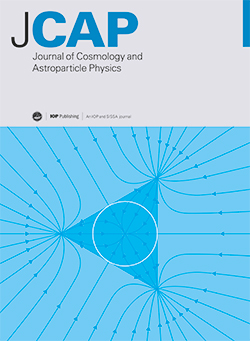Gauss-Bonnet Cosmology: large-temperature behaviour and bounds from Gravitational Waves
IF 5.3
2区 物理与天体物理
Q1 ASTRONOMY & ASTROPHYSICS
Journal of Cosmology and Astroparticle Physics
Pub Date : 2024-09-01
DOI:10.1088/1475-7516/2024/09/007
引用次数: 0
Abstract
We provide a transparent discussion of the high temperature asymptotic behaviour of Cosmology in a dilaton-Einstein-Gauss-Bonnet (dEGB) scenario of modified gravity with vanishing scalar potential. In particular, we show that it has a clear interpretation in terms of only three attractors (stable critical points) of a set of autonomous differential equations: w = -1/3, w = 1 and 1 < w < 7/3, where w ≡ p/ρ is the equation of state, defined as the ratio of the total pressure and the total energy density. All the possible different high-temperature evolution histories of the model are exhausted by only eight paths in the flow of the set of the autonomous differential equations. Our discussion clearly explains why five out of them are characterized by a swift transition of the system toward the attractor, while the remaining three show a more convoluted evolution, where the system follows a meta-stable equation of state at intermediate temperatures before eventually jumping to the real attractor at higher temperatures. Compared to standard Cosmology, the regions of the dEGB parameter space with w = -1/3 show a strong enhancement of the expected Gravitational Wave stochastic background produced by the primordial plasma of relativistic particles of the Standard Model. This is due to the very peculiar fact that dEGB allows to have an epoch when the energy density ρrad of the relativistic plasma dominates the energy of the Universe while at the same time the rate of dilution with T of the total energy density is slower than what usually expected during radiation dominance. This allows to use the bound from Big Bang Nucleosynthesis (BBN) to put in dEGB a constraint TRH ≲ (108 – 109) GeV on the reheating temperature of the Universe TRH. Such BBN bound is complementary to late-time constraints from compact binary mergers.高斯-波内特宇宙学:大温度行为和引力波边界
我们对具有消失标量势的稀释-爱因斯坦-高斯-波奈(dEGB)修正引力情景下宇宙学的高温渐近行为进行了透明的讨论。特别是,我们证明它可以用一组自主微分方程的三个吸引点(稳定临界点)来清楚地解释:w =-1/3,w = 1 和 1 < w < 7/3,其中 w ≡ p/ρ 是状态方程,定义为总压力和总能量密度之比。在自主微分方程组的流程中,只有八条路径可以穷尽模型所有可能的不同高温演化历史。我们的讨论清楚地解释了为什么其中五条路径的特点是系统迅速向吸引子过渡,而其余三条路径的演化则更为曲折,系统在中间温度下遵循元稳定状态方程,最终在较高温度下跃迁到真正的吸引子。与标准宇宙学相比,w = -1/3 的 dEGB 参数空间区域显示出标准模型相对论粒子原始等离子体产生的预期引力波随机背景的强烈增强。这是由于一个非常奇特的事实:当相对论等离子体的能量密度ρrad主导宇宙能量时,dEGB允许存在一个纪元,与此同时,总能量密度随T的稀释速度比通常预期的辐射主导时要慢。这使得我们可以利用大爆炸核合成(BBN)的约束,在 dEGB 中对宇宙的再热温度 TRH ≲ (108 - 109) GeV 进行约束。这种BBN约束是对来自紧凑双星合并的晚期约束的补充。
本文章由计算机程序翻译,如有差异,请以英文原文为准。
求助全文
约1分钟内获得全文
求助全文
来源期刊

Journal of Cosmology and Astroparticle Physics
地学天文-天文与天体物理
CiteScore
10.20
自引率
23.40%
发文量
632
审稿时长
1 months
期刊介绍:
Journal of Cosmology and Astroparticle Physics (JCAP) encompasses theoretical, observational and experimental areas as well as computation and simulation. The journal covers the latest developments in the theory of all fundamental interactions and their cosmological implications (e.g. M-theory and cosmology, brane cosmology). JCAP''s coverage also includes topics such as formation, dynamics and clustering of galaxies, pre-galactic star formation, x-ray astronomy, radio astronomy, gravitational lensing, active galactic nuclei, intergalactic and interstellar matter.
文献相关原料
| 公司名称 | 产品信息 | 采购帮参考价格 |
|---|
 求助内容:
求助内容: 应助结果提醒方式:
应助结果提醒方式:


